The Trades

Brickmasons, blockmasons, and stonemasons work in closely related trades creating attractive and durable surfaces and structures. The work varies in complexity, from laying simple walkway to installing ornate exterior on a high-rise building. Brickmasons and blockmasons - often called bricklayers - build and repair walls, floors, partitions, fireplaces, chimneys, and other structures with brick, precast masonry panels, concrete block and other masonry materials. Additionally, bricklayers specialize in installing firebrick linings in industrial furnaces. Stone masons build stonewalls, as well as set stone exteriors and floors. They work with two types of stone- natural cut such as marble or granite; and artificial stone made from concrete, marble chips, or other masonry materials.
Much of the work is done outdoors and is dependent on suitable weather conditions. It is a very strenuous trade with much stooping and lifting. A bricklayer must be able to work well in heights.

Carpenters build or remodel almost every kind of structure and represent several distinct classifications of workers. Cabinetmakers build and install cabinets, store fixtures, trade show displays, doors and windows, and moldings. Interior systems carpenters build interior walls and partitions with steel studs and apply the finish surfaces to walls and ceilings in commercial and residential buildings. Acoustical carpenter specialists specialize in the application of acoustical ceiling in commercial and residential buildings. Carpenters must be in good physical condition, agile, have good hand-eye coordination and have a productive attitude.

Cement masons and concrete finishers all work with concrete, one of the most common and durable materials used in construction. They place and finish the concrete. They may also color concrete surfaces; expose aggregate (small stones) in walls and sidewalks; or fabricate concrete beams, columns, and panels. Cement masons level (screed), shape, and smooth surfaces. The majority of their work is in industrial and commercial buildings. Cement masons must know the working characteristics of various cement and concrete mixes.

A heavy and highway construction craft laborer performs a variety of work assignments, including:
-
Installation of drainage pipe and structures
-
Traffic Zone Control and Flagging operations
-
Earth work, concrete and asphalt placement
-
Utility construction, such as:
-
Water mains and services
-
Gas mains and services
-
Telephone ducts and structures
-
Sanitary sewer systems
-

Construction electricians layout, assemble, install, repair, and test entire electrical and electronic systems. In addition to wiring a site’s electrical system, they install coaxial or fiber optic cable for computers and other telecommunications equipment. A number of electricians install telephone systems, computer networks, streetlights, intercom systems, and fire alarm and security systems plus other aspects of the Electrical industry. The work requires a thorough knowledge of the National Electrical Code, local electrical codes, and blueprint reading. Electricians must be mechanically inclined, physically fit, and enjoy working in various weather conditions. Mathematical formulas are part of the electrician’s everyday life.

Insulation workers may install many different types of insulating materials for basically five purposes: to prevent heat transfer; to conserve energy; to retard freezing; to protect personnel from burns; and to control mildew, mold, and fire hazards.
Work is done in hospitals, schools, commercial buildings, refineries, ships, and industrial plants in all kinds of indoor and outdoor climates, often in extremely hot or cold conditions. This trade has a high health hazard risk. Due to the dusty work conditions, workers must wear respirators. Workers must be able to lift, bend, carry, and not be afraid of heights or tunnels.

General Building Laborers Local 66 are skilled workers who provide much of the physical demanding labor on construction projects. They have a registered NYS apprenticeship program which trains new Laborers (apprentices) in the skills that are needed to succeed on construction sites. Journeymen Laborers also take classes through out the year to learn new skills and refine others.
Laborers Local 66 members perform work in concrete, mason tending ,site clean up, demolition, erecting scaffolding,maintain safety on construction site to just name a few. We work with all trades to keep there work areas safe clean and supply materials to allow them to perform there duties.
Local 66 Shop Stewards are required to be trained in all construction courses and additionally in CPR, First aid, and an annual shop steward refresher.
Local 66 members also are involved in many community volunteer projects; Flight 800, 9/11 Memorials in Eisenhower State Park, Veterans Memorial Park in Hauppauge, First responders park in Nesconset, Long Island Cares. Twice a year we host a blood drive with New York Blood Center, these are just a few of the things we do as Construction Craft Laborers!

Members of the Metallic Lathers and Reinforcing Ironworkers Local 46 bend, fabricate and install reinforcing steel in concrete. They install the ceiling frame for all acoustical and sheetrock ceilings. Members also install lath which is used in plaster applications found in Churches, Cathedrals, and in projects where developers want a more luxurious application than typical sheetrock construction.

Ornamental Ironworkers Local 580 install all miscellaneous iron including: stairs, rails, lentils, entrance ways, and lobby work consisting of stainless brass, aluminum and bronze metals. Windows installed into masonry pre-glazed curtain wall units are used to wrap the facade of most high rises in NYC. Local 580 also does the installation of all fence, guardrail, and sign structures.

-
Painters and decorators remove and apply protective and decorative coatings to homes, office buildings, hospitals, schools, and other commercial and industrial structures.
-
Drywall finishers apply multiple coats to sheet rock to prepare it to be painted or have other decorative finishes or materials applied.
-
Structural steel and bridge painters specialize in removing and applying protective coatings to bridges, ships, factories, and other structures.
-
Glaziers (architectural metal and glass workers) install and maintain structural and decorative glass, slope glazing, curtain walls and storefronts.
-
Metal polishers provide all types of protective coatings and lacquer for exposed metal including brass, copper, bronze and silver; they use regulated chemicals to ensure building fronts, entrance ways, facades, and lobbies are kept in tip top shape.

The plumber protects the health of the nation. Plumbers assemble, install and repair a variety of piping systems that carry water, waste, natural gas and medical gas in homes, schools, wastewater treatment plants, hospitals, and other commercial and public buildings. Plumbers play a role in the high tech world of today from space to the bottom of the ocean.

Roofers remove roofs, prepare roof surfaces and install new roofs. They work on a variety of buildings, protecting these facilities from water leaks and damage. Roofers need to be able to keep or regain body balance and stay upright when in an unstable position. They also need to be able to exert themselves physically over long periods of time without getting winded or short of breath.

Sheet metal workers fabricate, assemble, install, and repair fittings and ductwork used in construction or industry for heating, ventilation and air-conditioning systems in residential, commercial, and industrial applications. Work may involve any of the following: set up and operate fabricating machines to cut, bend, and straighten sheet metal; shape metal over anvils, blocks, or forms using a hammer; operate soldiering and welding equipment to join sheet metal parts; and inspect, assemble, and smooth seams and joints of burred surfaces. Sheet metal workers in manufacturing plants make sheet metal parts for products such as aircraft or industrial equipment.

Sign fabricators craft signs by hand from ferrous and non-ferrous materials. Tools used include state-of-the-art equipment such as computerized controlled cutting machines and computer driven plotters, as well as the traditional equipment such as hand tools, power brakes and power shears. Installers will operate hydraulic cranes and install all types of signs and sign structures.

A steamfitter fabricates and installs all equipment and piping that produces and/or transmits heat by: means of steam or hot water; hydraulic systems; air conditioning; refrigeration and ice machines; sprinkler; compressed air and pneumatic tube; process and general pipe fitting. The equipment and piping is installed in schools, hospitals, factories, sewage treatment and disposal plants, water treatment plants, co-generating facilities, and residential and office buildings.

Local unions 40 and 361 Iron Workers erect structural steel and precast concrete buildings, bridges, towers and stadiums. Iron Workers are trained riggers and machinery movers with the use of cranes. Members attend a three year apprentice program and extension courses. The licenses and certifications include New York State Welding, A.W.S., Certified Welding Inspector, Tower Crane Rigging, Scaffold Safety, OSHA 10 & 30 Safety Courses, Sub Part-R, MTA Track Training, plus Master Rigger, Site Safety Manager & Tower Crane Rigger from NYC Department of Building Licenses providing best trained and safest Iron Workers in the industry.

These craft workers lay marble and ceramic tiles and marble panels. They also mix, lay, and grind terrazzo (floor covering made of concrete and colored marble chips). Tile, marble, and terrazzo workers do new work as well as repair and remodel schools, hospitals, banks, office buildings, NYC subway stations, and retail shopping centers.




